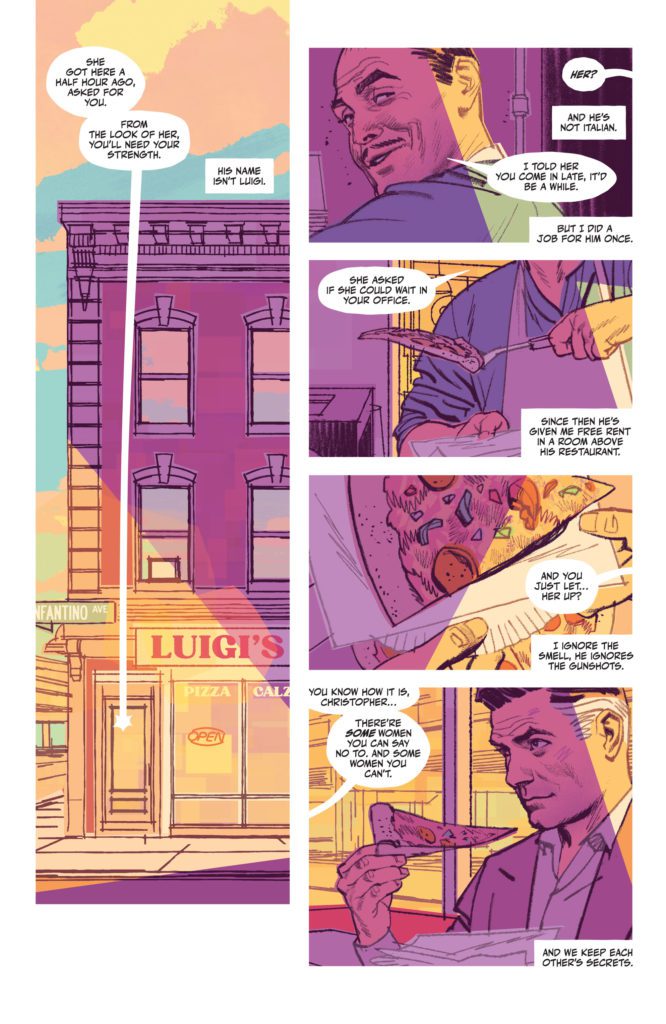“You know how it is, Christopher… There’re some women you can say no to. And some women you can’t.”
With this, writer Tom King introduces us to his take on the superhero, of Justice League International fame, known as Ice. When artist Greg Smallwood shows us this woman you can’t say no to, she’s not what you’d expect. She looks quiet and unassuming. Letterer Clayton Cowles delivers her first, rather short, line of dialogue in a three tiered word balloon. She’s gentle and careful in her speech. With this, we learn two things. One: Christopher Chance, the Human Target, is in big trouble. And two: so are we.
DC Comics’ The Human Target takes no prisoners. It gets its hooks into you, making you fall in love with characters, even when you know they’re doomed. Writer Tom King, artist Greg Smallwood, and letterer Clayton Cowles are masters of seduction.

Writing
King’s writing oozes with dramatic irony in The Human Target #2. Not only do we see how Chance keeps details of his poisoning close to the vest, but every innocent line from Ice is coupled with a caption box of Chance’s narration. He’s reading her like a book, but it’s not keeping him from being reeled in. Christopher Chance is decidedly not James Bond. He doesn’t have everything under control. He isn’t immortal or bulletproof, he’s not immune to a woman’s charms, and he doesn’t have a cure-all gadget up his sleeve. Christopher Chance is a human being. He’s capable of getting himself into all kinds of trouble. And Ice is trouble incarnate. This is why we can’t help but love them both.
Art
Smallwood’s art keeps us delightfully in the dark. While it’s tempting to claim these observations as my own, it’s actually Hassan Otsmane-Elhaou who made many of the discoveries I’m about to lay out, on his brilliant YouTube channel, Strip Panel Naked. First, Otsmane-Elhaou points out that Smallwood only shows us snippets of each scene. We rarely see a character’s full face. They’re either cut off in some way – seeing only their eyes, their lips, their chin – or they’re facing away. It’s the perfect approach to a mystery. We’re left piecing together each scene, trying to make sure we have all the right details.

Secondly, Otsmane-Elhaou discusses, The Human Target #1 showed nearly every panel from eye-level. We, as readers, are on Chance’s level. We relate to him, we solve this mystery with him. But The Human Target #2 is actually quite different in that regard. With Ice entering the picture, we are often looking down at her, and she’s often looking upwards towards Chance. Yet, as the issue progresses, their perspectives begin to level out. We even look up at Ice at some points, as she looks down towards Chance. Smallwood shows the tumultuous nature of their dynamic. This is not a woman Chance can simply understand and move on from. She’s changing as he watches her. She’s capable of more than he could know and he’s constantly reassessing her.
Coloring
Smallwood creates an atmosphere like no other artist. You can feel the warm air of his late mornings. You can feel the wind bite when he shows you a freezing day at the beach. But Smallwood’s coloring tells us more than just the temperature of each scene. When Ice tells Chance about her past, we see how she feels about everything. We see the soft blues of a melancholy childhood, the vibrant yellows of a joyful career in the Justice League, and then we see those moods collide in a fateful, complicated memory from that very morning. And all of it is done with a stunning attention to detail, especially in Smallwood’s use of light. The blocky shapes of sunlight look just like they would if you were squinting out at a real ocean. The dark shadows create a stark contrast to the bright spots on characters that have a chat out in the noonday sun. It’s a gorgeous mix of realism, impressionism, and pure comic book joy.

Lettering
This comic is smooth. Not just in its art and story, but in how it delivers its story. Cowles weaves us through each page seamlessly. But it takes a while to get to that point. When we first see Christopher Chance, he’s waking up. His caption boxes stick lazily to the bottom of each panel. His banter with Luigi, a chef in a pizza place, isn’t as smooth as it could be. Your eyes dart back and forth between their dialogue, dipping down to catch Chance’s captions which seem out of the way. But the caption boxes are mimicking Chance’s thoughts. He’s not thinking about Luigi, he’s thinking about how he’s dying. And when Ice arrives on the scene, the captions and dialogue become smoother than ever. We see Chance relax. We can see it in how he talks and how he thinks. He’s at ease, but he’s also fully present in each conversation.
DC Comics’ The Human Target is a stunning series. It’s outright seductive. Despite the dangers and doom these characters face, you have no choice but to love them. King, Smallwood, and Cowles deliver a mesmerizing issue that will pull you deeper still into this mystery. Pick up The Human Target #2, out from DC Comics November 30th, at a comic shop near you. You definitely don’t want to miss it!

